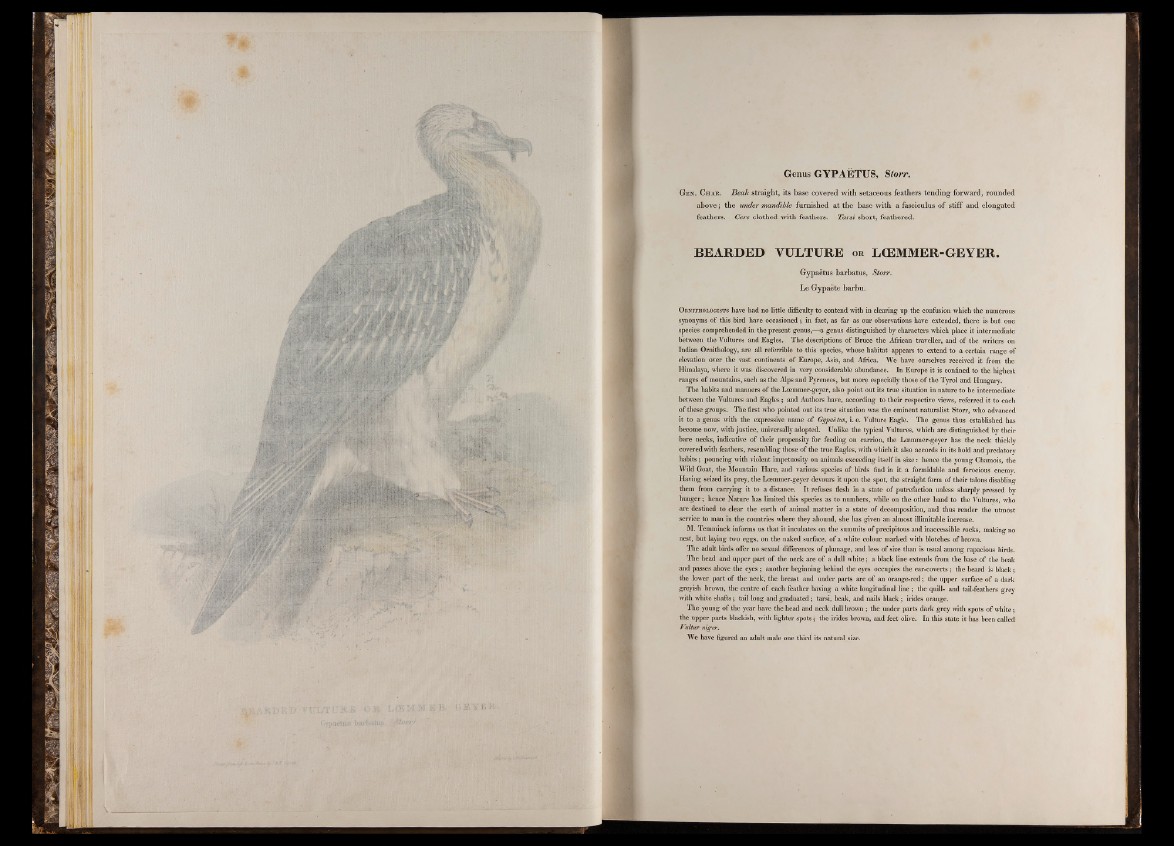
Genus GYPAETUS, Storr.
Gen. Char. Beale straight, its base covered with setaceous feathers tending forward, rounded
above; the imder mandible furnished at the base with a fasciculus o f stiff and elongated
feathers. Cere clothed with feathers. Tarsi short, feathered.
BEARDED VULTURE o r LCEMMER-GEYER.
Gypaetus barbatus, Storr.
Le Gypaete barbu.
O rnithologists have had no little difficulty to contend with in clearing up the confusion which the numerous
synonyms of this bird have occasioned; in fact, as far as our observations have extended, there is but one
species comprehended in the present genus,—a genus distinguished by characters which place it intermediate
between the Vultures and Eagles. The descriptions of Bruce the African traveller, and of the writers on
Indian Ornithology, are all referrible to this species, whose habitat appears to extend to a certain range of
elevation over the vast continents of Europe, Asia, and Africa. We have ourselves received it from the
Himalaya, where it was discovered in very considerable abundance. In Europe it is confined to the highest
ranges of mountains, such as the Alps and Pyrenees, but more especially those of the Tyrol and Hungary.
The habits and manners of the Lcemmer-geyer, also point out its true situation in nature to be intermediate
between the Vultures and Eagles; and Authors have, according to their respective views, referred it to each
of these groups. The first who pointed out its true situation was the eminent naturalist Storr, who advanced
it to a genus with the expressive name of Gypaetus, i. e. Vulture Eagle. The genus thus established has
become now, with justice, universally adopted. Unlike the typical Vultures, which are distinguished by their
bare necks, indicative of their propensity for feeding on carrion, the Loemmer-geyer has the neck thickly
covered with feathers, resembling those of the true Eagles, with which it also accords in its bold and predatory
habits; pouncing with violent impetuosity on animals exceeding itself in size: hence the young Chamois, the
Wild Goat, the Mountain Hare, and various species of birds find in it a formidable and ferocious enemy.
Having seized its prey, the Loemmer-geyer devours it upon the spot, the straight form of their talons disabling
them from carrying it to a distance. It refuses flesh in a state of putrefaction unless sharply pressed by
hunger; hence Nature has limited this species as to numbers, while on the other hand to the Vultures, who
are destined to clear the earth of animal matter in a state of decomposition, and thus render the utmost
service to man in the countries where they abound, she has given an almost illimitable increase.
M. Temminck informs us that it incubates on the summits of precipitous and inaccessible rocks, making no
nest, but laying two eggs, on the naked surface, of a white colour marked with blotches of brown.
The adult birds offer no sexual differences of plumage, and less of size than is usual among rapacious birds.
The head and upper part of the neck are of a dull white; a black line extends from the base of the beak
and passes above the eyes ; another beginning behind the eyes occupies the ear-coverts; the beard is black;
the lower part of the neck, the breast and under parts are of an orange-red; the upper surface of a dark
greyish brown, the centre of each feather having a white longitudinal line ; the quill- and tail-feathers grey
with white shafts; tail long and graduated; tarsi, beak, and nails black; irides orange.
The young of the year have the head and neck dull brown ; the under parts dark grey with spots of white;
the upper parts blackish, with lighter spots; the irides brown, and feet olive. In this state it has been called
Vultur niger.
We have figured an adult male one third its natural size.